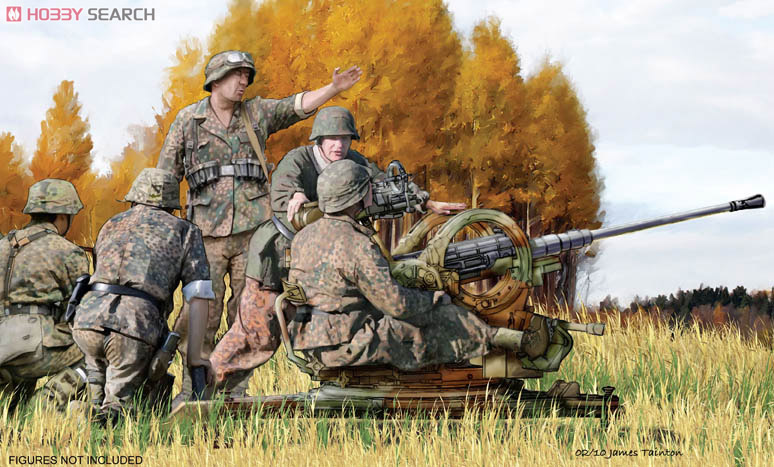
2-cm Flak 30
By the time the new German army was ready to re-arm during the early 1930s, the German armament manufacturers had built up a considerable degree of expertise in heavy automatic weapons. This was especially true of the giant Rheinmetall-Borsig concern, and accordingly it was given a contract to produce a light anti-aircraft gun with a calibre of 20mm (0.787 in), and this was ready for service by 1935. Known as the 2-cm Flak 30, the term Flak standing for Fliegerabwehrkanone (anti-aircraft gun), this light weapon was of the type often known as a cannon, and was the first of a series of weapons t h a t were to become dreaded by low-flying Allied aircraft crews.
The Flak 30 was for its light calibre a rather complex weapon mounted on a carriage that could be towed on two wheels and in action rested on a ground platform. This platform provided a stable firing base with 360° traverse, and had a seat behind the gun for the firer who used, in the Flak 30’s original form, a rather complicated form of reflector sight. These sights became even more complicated when simple predictor systems were built into it, and at one point the small sight had reached a state when it had to be driven by clockwork. In fact they got so complicated that the whole idea was dropped and later versions reverted to simple ‘cartwheel and bead’ iron sights. The gun had a crew of five, but in action was frequently managed by less, especially when the guns were located in static positions, Generally the number was at least four, and usually one man held and operated a stereoscopic rangefinder, though after 1944 this function was deleted as it was found to be operationally unnecessary.
Ammunition was fed into the gun in 20-round magazines, but for some never-fully determined reason the Flak 30 was prone to ammunition jams, Also, although it was perfectly adequate when first introduced, it was later discovered that its rate of fire was too slow to cope adequately with the increased aircraft speeds that prevailed after 1940. Consequently it was replaced on the production line by the later Flak 38, but those already in service were not replaced until they became worn out or were lost to enemy action. In army light anti – aircraft Abteilungen (battalions) there were usually three 2-cm batteries to one 3.7- cm (1.457-in) battery, but as the war continued there were many variations on this theme. The Flak 30 was used not only by the Germans. Before 1939 some were sold to the Netherlands and even to China. In Germany the Flak 30 was also used by the Luftwaffe for ground defences, and the German navy had many specialized naval mountings. Some saw service for the defence of armoured trains, and the weapon was one of those mounted on several types of halftracks or trucks for the defence of mobile formations and convoys. The Flak 30 was frequently used in the ground target role, and there was even a special armour-piercing round for use against tanks.
2-cm Flak 38
By 1940 it was already appreciated that the low rate of fire of the2-cm(0.787-in) Flak 30 was too low for future target speeds, so it was decided to increase the rate of fire in order to increase the possible numbers of projectiles hitting the target. It was also decided to redesign the gun to get rid of the inherent jamming problem. Rheinmetall-Borsig was not given the contract for this project. It went instead to Mauser, who came up with a new gun that was outwardly similar to the Flak 30 but internally much was changed to provide a cyclic rate of fire of 420 to 480 rounds per minute. The ammunition, feed system and most of the carriage remained much the same as before. So did the complicated sights which were later simplified, as on the Flak 30.
The 2-cm Flak 38, as the Mauser, design was known, entered service in late 1940 and eventually replaced the Flak 30 on the production lines. It served alongside the Flak 30 and was also used by the Luftwaffe and the German navy. There was even a special version for use by the German army’s mountain units that could be broken down into pack loads. This used the same gun as the Flak 38, but the carriage was much smaller and lighter: it was known as the 2-cm Gebirgsflak 38 and was intended to be a dual-purpose weapon for use against ground targets as well as against aircraft. By 1940 it was appreciated that aircraft targets were not only getting faster but also heavier and better protected against ground and air fire. Undertaken with typical German thoroughness, operational analysis revealed that although the high rate of fire of the Flak 38 was more likely to ensure a target hit, the low explosive payload of the projectile was unlikely to inflict enough damage to ensure a ‘kill’.